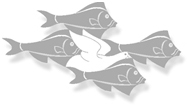

|
|
|
|
R.D. Hersch, F. Crété
IS&T/SPIE Electronic Imaging Symposium, Conf. Imaging X: Processing, Hardcopy and Applications, SPIE Vol. 5667, 2005, pp. 434-445
Dot gain is different when dots are printed alone, printed in superposition with one ink or printed in superposition with two inks. In addition, the dot gain may also differ depending on which solid ink the considered halftone layer is superposed. In a previous research project, we developed a model for computing the effective surface coverage of a dot according to its superposition conditions. In the present contribution, we improve the Yule-Nielsen modified Neugebauer model by integrating into it our effective dot surface coverage computation model. Calibration of the reproduction curves mapping nominal to effective surface coverages in every superposition condition is carried out by fitting effective dot surfaces which minimize the sum of square differences between the measured reflection density spectra and reflection density spectra predicted according to the Yule-Nielsen modified Neugebauer model. In order to predict the reflection spectrum of a patch, its known nominal surface coverage values are converted into effective coverage values by weighting the contributions from different reproduction curves according to the weights of the contributing superposition conditions. We analyze the colorimetric prediction improvement brought by our extended dot surface coverage model for clustered-dot offset prints, thermal transfer prints and ink-jet prints. The color differences induced by the differences between measured reflection spectra and reflection spectra predicted according to the new dot surface estimation model are quantified on 729 different cyan, magenta, yellow patches covering the full color gamut. As a reference, these differences are also computed for the classical Yule-Nielsen modified spectral Neugebauer model incorporating a single halftone reproduction curve for each ink. Taking into account dot surface coverages according to different superposition conditions considerably improves the predictions of the Yule-Nielsen modified Neugebauer model. In the case of offset prints, the mean difference between predictions and measurements expressed in CIE-LAB CIE-94 DE94 values is reduced at 100 lpi from 1.54 to 0.90 (accuracy improvement factor: 1.7) and at 150 lpi it is reduced from 1.87 to 1.00 (accuracy improvement factor: 1.8). Similar improvements have been observed for a thermal transfer printer at 600 dpi, at lineatures of 50 and 75 lpi. In the case of an ink-jet printer at 600 dpi, the mean DE94 value is reduced at 75 lpi from 3.03 to 0.90 (accuracy improvement factor: 3.4) and at 100 lpi from 3.08 to 0.91 (accuracy improvement factor: 3.4).
Download the full paper: PDF 128 KB
![]()
![]()
![]()
![]()
![]()